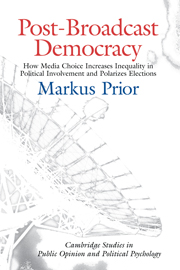 Post-Broadcast Democracy
Post-Broadcast Democracy Published online by Cambridge University Press: 05 July 2014
Few people could deny that life would be different without television. Most Americans with cable or satellite television would agree that greater media choice has affected their evenings. Many Internet users might not remember when they last picked up a phone book or went to a book store. It may be a cliché that new media change people's lives, but with regard to many routine tasks, it is also a truism.
And yet, political scientists use the same models that were used twenty years ago to explain political behavior. Judging by their models, most political scientists believe that politics would not be so different without television, that they can safely ignore the expansion of viewer choice that came with cable, and that the Internet is little more than a newspaper without the paper. The media environment is barely on the map of political science. Studies that state explicitly whether and how political behavior would be different in a different media environment are few and far between.
This study has demonstrated that changes in the media environment affect politics. The advent of television changed news exposure, political knowledge, and turnout. Cable television and the Internet changed them again. The political relevance goes beyond political involvement. Changes in the media environment caused congressional incumbents to do better in the 1960s and elections to become polarized in recent decades.
In this chapter, I briefly summarize the key findings as well as some limitations of this study.
To save this book to your Kindle, first ensure [email protected] is added to your Approved Personal Document E-mail List under your Personal Document Settings on the Manage Your Content and Devices page of your Amazon account. Then enter the ‘name’ part of your Kindle email address below. Find out more about saving to your Kindle.
Note you can select to save to either the @free.kindle.com or @kindle.com variations. ‘@free.kindle.com’ emails are free but can only be saved to your device when it is connected to wi-fi. ‘@kindle.com’ emails can be delivered even when you are not connected to wi-fi, but note that service fees apply.
Find out more about the Kindle Personal Document Service.
To save content items to your account, please confirm that you agree to abide by our usage policies. If this is the first time you use this feature, you will be asked to authorise Cambridge Core to connect with your account. Find out more about saving content to Dropbox.
To save content items to your account, please confirm that you agree to abide by our usage policies. If this is the first time you use this feature, you will be asked to authorise Cambridge Core to connect with your account. Find out more about saving content to Google Drive.